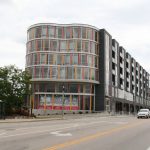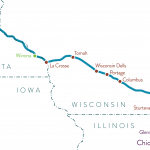Lake Park Bridge Faces Thorny Issues
Citizens narrow options, but funding issue still makes any solution tough to accomplish.
Options for how to handle the deteriorated 110-year-old Concrete Arch Footbridge in Milwaukee’s Lake Park were informally narrowed during a recent packed-house public meeting of about 75 citizens in Lake Park’s pavilion. Nonetheless, complicated issues — including how to pay for it — must still be addressed before any plan for the historic bridge could advance.
After two restoration plans and three replacement concepts were presented, Milwaukee County Supervisor Sheldon Wasserman, whose district includes Lake Park, conducted a straw poll. Votes were almost equally split between a long-term restoration proposal by Olson & Nesvold Engineers (lasting 40-50 years) and a faithful replica of the bridge. GRAEF-USA’s shorter-term restoration (for 15-25 years) won two votes and two contemporary replacement designs by UW-Milwaukee’s Historic Preservation Institute received one nod each.
Outright removal of the bridge, though mentioned, was not polled. One woman proposed immediate demolition so Ravine Road, closed since December 2014, could reopen while solutions are explored. No one else expressed support for this.
GRAEF, a Milwaukee engineering firm, and county administrators hosted the event. Presentations discussed engineering, cost estimates, aesthetic issues and preservation standards. Cost estimates of $1.75 million to $2.3 million were based on several consistent factors, such as a single deck rail style. Officials, however, stressed that the estimates are “very rough” until final drawings are completed. One figure already fluctuated from last month when the estimate to create a replica of the bridge was pegged at $2.6 million, up from $2.3 million.
The Lake Park Bridge Work Group, whose members include county officials, project contractors, historic preservation officials, park friends, and neighbors, are charged with recommending a single preferred option by the end of summer.
The Hunt for Funding
Securing funding for a bridge project could prove challenging. Wasserman has expressed doubts he could win support from County Executive Chris Abele and the board for any multimillion-dollar bridge plan, since the county’s entire 2016 capital budget for parks is merely $6 million, and the county, has a backlog of deferred maintenance in the parks.
The federal Transportation Alternatives Program (TAP) was presented as the most likely prospect for funding. Administered by the Wisconsin Department of Transportation (WisDOT), TAP grants fund up to 80 percent of project costs. One category is for “preservation of historic transportation structures” including bridges. The project would rank even higher if the multi-modal route that includes the footbridge is designated as a spur of the county’s Oak Leaf Trail. County officials say that is “do-able.”
Bob Schmidt, WisDOT’s Southeastern Region coordinator, told Urban Milwaukee he believes a new pedestrian bridge would be eligible in another category: “Construction, planning, and design of on-road and off-road trail facilities for pedestrians, bicyclists, and other non-motorized forms of transportation.” However, Schmidt noted that a replacement bridge “may not be a highly competitive project when it comes down to project selection, since it has a pretty significant price tag.”
Preservation Protocols
A plan for a replica would also first need to scale other hurdles. In a nutshell: “Rehabilitation should always be considered as the preferred treatment for a historic bridge,” according to protocols established by Milwaukee County Parks and WisDOT in a Historic Properties Management Plan in 2013. The HPMP guidelines reflect the Secretary of Interior Standards for the Treatment of Historic Properties, which are …intended to guide future activities so appropriate maintenance and preservation decisions are made…” There are specific federal standards for bridge preservation. The long-term rehabilitation proposal by Olson & Nesvold Engineers, historic bridge experts based in Bloomfield, Minnesota, would follow federal protocols when replacing some deteriorated bridge material and reinforcing the bridge’s internal structure. It would “maintain historic character-defining elements, while providing structural integrity.”
Lake Park is Milwaukee County’s only park listed in entirety on the National Register of Historic Places. The Ravine Road bridge is a “contributing architectural resource.”
Historian John Vogel, a GRAEF subcontractor, told attendees that even though the state historic preservation office monitors National Register properties, it “does not have the final say.” The county board, as stewards of the asset, establishes policy relating to county park facilities. Nonetheless, the state office could decide the action would have an “adverse effect” on a historic resource and strongly recommend substantial “mitigation” to make up for the loss of a valued asset. Depending on the mitigating efforts, that could add significantly to project costs.
Lake Park and the Ravine Road footbridge are also within a City of Milwaukee historic district. Thus, the city’s Historic Preservation Commission must review and approve plans for the bridge for “appropriateness.” Patti Keating Kahn, the commission chair, noted that design details such as deck-rail style would be scrutinized. It’s been a point of agreement thus far that any design should include open rails, an elegant feature of the original bridge. They were replaced years ago with solid concrete panels.
New Historic Study
Carlen Hatala, senior planner for the City of Milwaukee’s Historic Preservation Office, also presented highlights of a just-completed, 65-page “cultural heritage assessment” of the bridge. Hatala worked with three preservation interns—Emma Rudd, Leila Saboori and Nader Sayadi–from UW-Milwaukee to synthesize background about the bridge and place it in context. She encouraged attendees to consider “how we determine significance” and what type of value the community might accord to a historic, one-of-a-kind bridge. She also wondered why Wisconsin has not been able to save more bridges.
The study analyzed extensive archival information about the bridge and Lake Park, which is “locally and nationally recognized as a significant historic place.” It explained how each of the park’s five major bridges contributed to acclaimed landscape architect Frederick Law Olmsted’s vision and the park’s intact legacy of “wholeness and authenticity.” Olmsted’s design placed bridges at specific locations to span existing deep ravines, thus capitalizing on naturally dramatic changes in grade.
The report called the Ravine Road bridge part of a continuous sequence along the “pathway which winds above the bluff…designed as the spatial spine of the park.” The route “not only provides amazing views towards the lake along the crest…but also ties the main spaces and structures of the park…” Today, the mile-long promenade routinely attracts a steady flow of people of all ages, including parents pushing strollers, skateboarders, joggers, bicyclists and birders as well as wedding parties and others taking special-event portraits. In recent weeks, hundreds of mostly young people have been roaming along the path, cell phones in hand, hunting for “Pokeman Go” prey.
The report also highlights the bridge’s architects, George Bowman Ferry and Alfred C. Clas of the renowned firm Ferry & Clas. Research indicates it’s the only bridge they designed together. It was part of a “cluster” of neoclassical structures the firm designed for the park that included the pavilion and Grand Stairway, as well as a band shell that no longer exists. The bridge is also considered important for its “modernist” cutouts and bridge-engineering innovations when concrete was a new technology.
Next Steps
Attendees expressed a desire for more information about funding options, preservation protocols, and the proposed long-term restoration plan. However, this was the second and final meeting GRAEF was required to host as part of its contract signed with the county in February to explore bridge options. County administrators or the board could also host public hearings.
Once the Bridge Work Group recommends a preferred option to the board and county executive, the board will hear the issue. Some funding still remains from $400,000 the board allocated in 2015 for bridge study and design. Discussions will also continue at the city and state level about preservation protocols and whether specific approaches would be deemed “appropriate.”
Federal funding is the most likely option to make any bridge project feasible. However, plans to apply for federal funds, whether for restoration or a replacement, would also trigger a rigorous review under Section 106 of the National Historic Preservation Act of 1966. A restoration plan in keeping with federal preservation guidelines might be blessed with relative ease. The county/WisDOT management plan notes that “It is the intent for the County, agencies and municipalities to follow this HPMP to be eligible to receive federal funding and obtain required federal permits in accordance with Section 106 requirements.”
However, plans for a replacement bridge would likely face more complicated layers of scrutiny and regulations before a grant could be submitted in what officials consider a “very competitive process.”
Friends and neighbors of Lake Park have expressed worry that if federal funding is not secured, removal of the bridge—without replacement—remains a very real threat. Demolition, estimated to cost about $300,000, could be pitched as the only option the county can afford.
That would be a loss, from the standpoint of preservationists like Kitty Henderson, executive director of the Historic Bridge Foundation. As she has written: “replacement is almost always seen as the cheaper, and thus, best route. What is lost in the calculated costs of replacing or rehabilitating a historic bridge is the intrinsic value of the bridge itself.”
More about the Ravine Road Bridge Project
- City Should Enforce Reopening of Ravine Road, Park Friends Say in Filing - Lake Park Friends - Sep 28th, 2023
- MKE County: Ravine Road Debate Heats Up - Graham Kilmer - Aug 14th, 2023
- MKE County: Ravine Road Project Could Begin in 2024, With Pedestrian-Only Option - Graham Kilmer - Aug 1st, 2023
- MKE County: Lake Park Bridge Open For First Time In 6 Years - Graham Kilmer - Oct 29th, 2022
- Friday Photos: Lake Park Bridge Overhaul Nears Completion - Jeramey Jannene - Sep 23rd, 2022
- MKE County: Lake Park Bridge Needs $1 Million More - Graham Kilmer - May 18th, 2021
- County Receives $2 Million Grant for Lake Park Bridge - County Executive Chris Abele - Sep 12th, 2018
- County Parks To Seek State Grant to Fund Ravine Road Bridge Project - Milwaukee County Parks - Feb 8th, 2018
- Op-Ed: Lake Park’s Bridge Spans History - Paul Daniel Marriott - Apr 5th, 2017
- Public Forum For Lake Park Bridge - Virginia Small - Feb 13th, 2017
Read more about Ravine Road Bridge Project here



















It’s a bit disingenuous to imply that the cost of bridge repair/reconstruction/replacement would have to come out of the County’s annual $6 million maintenance budget. Because the resulting bridge would last 20-100 years, depending on the option selected, it would be appropriate for bonding, which would impact the annual budget much, much less.
Any news about Lake Park and funding always makes me wonder how much $$ value the City of Milwaukee and Milwaukee County place on it with it’s renowned provenance..
Is there a published dollar value on what the larger Olmsted designed park has produced, or can produce over the years?
That should surely affect attitudes toward continuous maintenance of other necessary features, like bridges, added later. (Although to my 30+ years of memory of the park, continuous maintenance hadn’t always been done to maintain the Olmsted design over the years.)
Reporting in this series has stated that variations to the original design have been questioned for what is now a pedestrian thoroughfare. Who could possibly voice that openly in today’s environment*. Buggy and equestrian traffic in the park ended years ago.
(Milwaukee’s architectural elite casually ignore the changes made on Milwaukee’s well-known buildings showing evidence of bad architectural circumcision like the Railway Exchange bldg., Goll / Renaissance bldg., and most shameful of all, the disfigured Journal/Sentinel bldg.)
Aren’t there well-paid and pensioned Milwaukee City and Milwaukee County employees hired to make these decisions and execute the plans? It seems inconceivable to a citizen like me that a decorative pedestrian bridge cannot be rebuilt with today’s construction products and techniques without a citizen’s action movement.
Maybe it’s just another example of Milwaukee’s 3 speeds: Slow, Block and Stop. The lower drive through the park has already been “stopped” for 2+ years? Again, any “book value” of this particular park, with it’s provenance, seems to be negligible at best for those entrusted with its maintenance.
Two more clarifications:
Gary – the bridge, located in a county park, is wholly the financial responsibility of the County, not the City.
Virginia – you may have left the meeting a tad early. After the first vote was taken, more information on the top two vote getters was requested. When that information had been obtained, a second vote was taken and rebuilding the bridge to its original design (with some modification to accommodate modern bridge code) was the clear winner, with about two-thirds of the votes.
Barb, the $6 million figure applies to capital improvement projects. About 20 percent is cash-financed and the rest is bonded or from other sources including federal funding, such as TAP grants. It does not include annual operating maintenance.
The county’s “deferred maintenance” generally refers to major capital projects. Officials say it’s roughly $400 million to $500 million. Routine maintenance has also been reduced but is is not generally included in that estimate.
Here’s the parks link about capital projects: http://county.milwaukee.gov/ParksCIP
For anyone wanting to wade through the weeds, here’s the entire capital budget:
http://county.milwaukee.gov/ImageLibrary/Groups/cntyDAS/PSB/Budgets/2016-Budget/2015-Recommended-Budget/CEXCapital.pdf
Sounds like a tough question. Replace or restore? On the one hand, it’s not like the bridge is ancient. It’s an antique, I suppose, but how do we know it’s historic significance? On the other, the existing bridge has been there since 1908. Generations of Milwaukeans and visitors have walked across it, seen its views; been there. It’s an important piece of the Lake Park experience–one of the few places I can think of here where anyone can go to get a feel for that history. To step back in time. The experience is embodied in the actual bridge more than the mere idea of it. The idea can be replicated, but the replica never feels the same, no matter how faithful. Or, maybe it’s just the functionality that matters. They did that at Brady St a few years back with the pedestrian bridge across Lincoln Memorial Drive and that seems to be working pretty well. A comprehensive restoration (including the original balustrades) would be better than a replacement.
Barbara, thanks for the clarifications.
Gary, I’ve not seen an economic-impact study about Lake Park or other parks. However, studies have demonstrated significant increased property values of homes near parks and trails. Frederick Law Olmsted actually conducted the first such study about Central Park; he used it to get more funding for later phases. Increased tax base was also his rationale for creating “parkways” that extended proximity to parks, a concept Milwaukee incorporated as it designed the parks system.
.
http://www.huffingtonpost.com/charles-a-birnbaum/living-on-the-edge_b_5499647.html
As Barbara noted, county officials are guiding the process. Citizens have some input, as with other parks issues, and have attended public info meetings since the issues are fairly complex. Being on the National Register and in a local historic district increases that complexity. The City will play a role in plan approval. State and federal preservation agencies will have an advisory role.
Just mentioning that there is an error in text. It states the bridge has been closed since December 2104, it should be 2014.